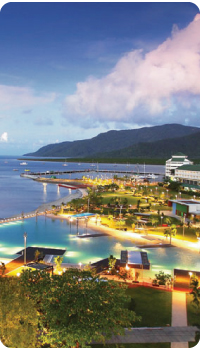
![]()
About Cairns
 Cairns is a regional city in Far North Queensland, Australia. The city was named after William Wellington Cairns (then Governor of Queensland). It was formed to serve miners heading for the Hodgkinson River goldfield, but experienced a decline when an easier route was discovered from Port Douglas. It later developed into a railhead and major port for exporting sugar cane, gold and other metals, minerals and agricultural products from surrounding coastal areas and the Atherton Tableland region.
Cairns is a regional city in Far North Queensland, Australia. The city was named after William Wellington Cairns (then Governor of Queensland). It was formed to serve miners heading for the Hodgkinson River goldfield, but experienced a decline when an easier route was discovered from Port Douglas. It later developed into a railhead and major port for exporting sugar cane, gold and other metals, minerals and agricultural products from surrounding coastal areas and the Atherton Tableland region.
The city is rapidly expanding, with a population of 122,731 at the 2006 census. Tourism is the largest income producer for the region, followed closely by the sugar industry.[citation needed] An intercensal estimate for the resident population the Local Government Area as of June 2008 was 158,700.
Cairns is located about 1,700 km (1,056 mi) from Brisbane, and about 2,420 km (1,504 mi) from Sydney by road. It is a popular travel destination for foreign tourists because of its tropical climate and proximity to many attractions. The Great Barrier Reef can be reached in less than an hour by boat. Daintree National Park and Cape Tribulation, about 130 km (81 mi) north of Cairns, are popular areas for experiencing a tropical rainforest. It also serves as a starting point for people wanting to explore Cooktown, Cape York Peninsula, and the Atherton Tableland.
Various parks and attractions take advantage of the city's natural surroundings. Among them are Rainforestation Nature Park, Tjapukai Aboriginal Cultural Park, and Kuranda Skyrail Rainforest Cableway, which extends for 7.5 km (4.7 mi) over World Heritage rainforest.
A notable feature of the Cairns esplanade is a swimming lagoon with adjoining barbecue areas. In May 2003, the then Cairns Mayor Kevin Byrne declared that topless sunbathing is permitted here, as the area is a gathering point for people from around the world who may wish to do so. A boardwalk allows pedestrians and cyclists to move along the foreshore from the lagoon.